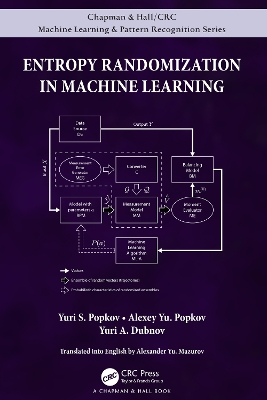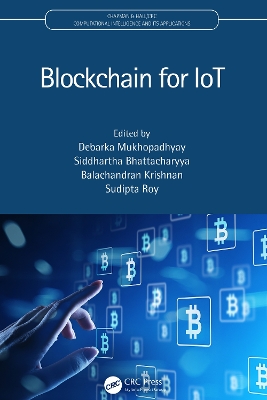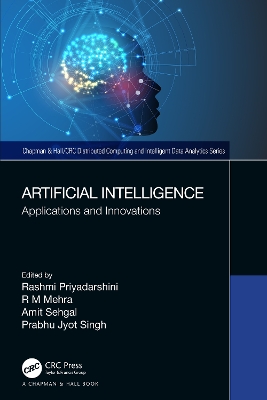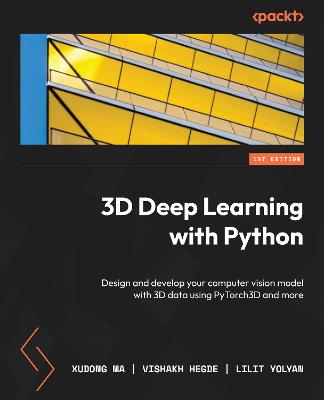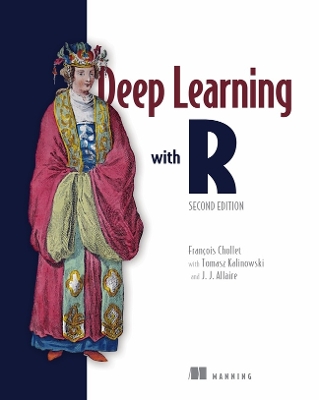Artificial Intelligence Techniques in IoT Sensor Networks
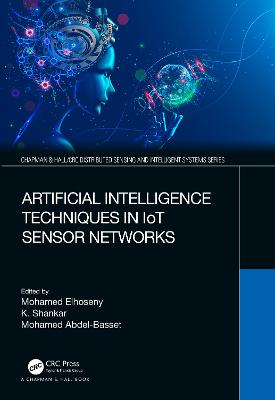 portes grátis
portes grátis
Artificial Intelligence Techniques in IoT Sensor Networks
Elhoseny, Mohamed; Abdel-Basset, Mohamed; Shankar, K
Taylor & Francis Ltd
08/2022
221
Mole
Inglês
9780367681456
15 a 20 dias
426
Descrição não disponível.
Preface
Chapter 1
Adaptive Regularized Gaussian Kernel FCM for the Segmentation of Medical Images - An Artificial Intelligence Based IoT Implementation for Teleradiology Network
1.1 Introduction
1.2 Proposed Methodology
1.2.1 Fuzzy C Means Clustering
1.3 Results and Discussion
1.4 Conclusion
References
Chapter 2
Artificial Intelligence Based Fuzzy Logic with Modified Particle Swarm Optimization Algorithm for Internet of Things Enabled Logistic Transportation Planning
2.1. Introduction
2.2. Related works
2.3. Proposed Method
2.3.1. Package Partitioning
2.3.2. Planning of delivery path using HFMPSO algorithm
2.3.3. Inserting Pickup Packages
2.4. Experimental Validation
2.4.1. Performance analysis under varying package count
2.4.2. Performance analysis under varying vehicle capacities
2.4.3. Computation Time (CT) analysis
2.5. Conclusion
References
Chapter 3
Butterfly Optimization based Feature Selection with Gradient Boosting Tree for Big Data Analytics in Social Internet of Things
3.1. Introduction
3.2. Related works
3.3. The Proposed Method
3.3.1. Hadoop Ecosystem
3.3.2. BOA based FS process
3.3.3. GBT based Classification
3.4. Experimental Analysis
3.4.1. FS Results analysis
3.4.2. Classification Results Analysis
3.4.3. Energy Consumption Analysis
3.4.4. Throughput Analysis
3.5. Conclusion
References
Chapter 4
An Energy Efficient Fuzzy Logic based Clustering with Data Aggregation Protocol for WSN assisted IoT system
4. 1. Introduction
4. 2. Background Information
4. 2.1. Clustering objective
4. 2. 2. Clustering characteristics
4. 3. Proposed Fuzzy based Clustering and Data Aggregation (FC-DR) protocol
4. 3. 1. Fuzzy based Clustering process
4. 3. 2. Data aggregation process
4. 4. Performance Validation
4. 5. Conclusion
References
Chapter 5
Analysis of Smart Home Recommendation system from Natural Language Processing Services with Clustering Technique
5. 1. Introduction
5. 2. Review of Literatures
5. 3. Smart Home- Cloud Backend Services
5. 3.1 Internet of Things (IoT)
5. 4. Our Proposed Approach
5. 4.1 Natural Language Processing Services (NLPS)
5. 4. 2 Pipeline Structure for NLPS
5. 4. 3 Clustering Model
5. 5. Results and analysis
5. 6. Conclusion
References
Chapter 6
Metaheuristic based Kernel Extreme Learning Machine Model for Disease Diagnosis in Industrial Internet of Things Sensor Networks
6. 1. Introduction
6. 2. Proposed Methodology
6. 2. 1. Deflate based Compression Model
6. 2. 2. SMO-KELM based Diagnosis Model
6. 3. Experimental results and validation
6. 4. Conclusion
References
Chapter 7
Fuzzy Support Vector Machine with SMOTE for Handling Class Imbalanced Data in IoT Based Cloud Environment
7. 1. Introduction
7. 2. The Proposed Model
7. 2.1. SMOTE Model
7. 2.2. FSVM based Classification Model
7. 3. Simulation Results and Discussion
7. 4. Conclusion
References
Chapter 8
Energy Efficient Unequal Clustering Algorithm using Hybridization of Social Spider with Krill Herd in IoT Assisted Wireless Sensor Networks
8. 1. Introduction
8. 2. Research Background
8. 3. Literature survey
8. 4. The proposed SS-KH algorithm
8. 4. 1. SS based TCH selection
8. 4. 2. KH based FCH algorithm
8. 5. Experimental validation
8. 5. 1 Implementation setup
8. 5. 2. Performance analysis
8. 6. Conclusion
References
Chapter 9
IoT Sensor Networks with 5G Enabled Faster RCNN Based Generative Adversarial Network Model for Face Sketch Synthesis
9. 1. Introduction
9. 2. The Proposed FRCNN-GAN Model
9. 2.1. Data Collection
9. 2.2. Faster R-CNN based Face Recognition
9. 2.3. GAN based Synthesis Process
9. 3. Performance Validation
9. 4. Conclusion
References
Chapter 10
Artificial Intelligence based Textual Cyberbullying Detection for Twitter Data Analysis in Cloud-based Internet of Things
10. 1. Introduction
10. 2. Literature review
10. 3. Proposed Methodology
10. 3.1. Preprocessing
10. 3.2. Feature extraction
10. 3.3. Feature selection using ranking method
10. 3.4. Cyberbully detection
10. 3.5. Dataset Description
10. 4. Result and discussion
10. 4.1. Evaluation Metrics
10. 4.2. Comparative analysis
10. 5. Conclusion
References
Chapter 11
An Energy Efficient Quasi Oppositional Krill Herd Algorithm based Clustering Protocol for Internet of Things Sensor Networks
11. 1. Introduction
11. 2. The Proposed Clustering algorithm
11. 3. Performance Validation
11. 4. Conclusion
References
Chapter 12
An effective Social Internet of Things (SIoT) Model for Malicious node detection in wireless sensor networks
12. 1. Introduction
12. 2. Review of Recent Kinds of literature
12. 3. Network Model: SIoT
12. 3.1 Malicious Attacker Model in SIoT
12. 4. Proposed MN in SIoT System
12. 4.1 Trust based Grouping in SIoT network
12. 4.2 Exponential Kernel Model for MN detection
12. 4.3.1 Example of Proposed Detection System
12. 4.4 Detection Model
12. 5. Results and analysis
12. 6. Conclusion
References
Chapter 13
IoT Based Automated Skin Lesion Detection and Classification using Grey Wolf Optimization with Deep Neural Network
13. 1. Introduction
13. 2. The Proposed GWO-DNN Model
13. 2.1. Feature Extraction
13. 2.2. DNN based classification
13. 3. Experimental Validation
13. 4. Conclusion
References
Index
Chapter 1
Adaptive Regularized Gaussian Kernel FCM for the Segmentation of Medical Images - An Artificial Intelligence Based IoT Implementation for Teleradiology Network
1.1 Introduction
1.2 Proposed Methodology
1.2.1 Fuzzy C Means Clustering
1.3 Results and Discussion
1.4 Conclusion
References
Chapter 2
Artificial Intelligence Based Fuzzy Logic with Modified Particle Swarm Optimization Algorithm for Internet of Things Enabled Logistic Transportation Planning
2.1. Introduction
2.2. Related works
2.3. Proposed Method
2.3.1. Package Partitioning
2.3.2. Planning of delivery path using HFMPSO algorithm
2.3.3. Inserting Pickup Packages
2.4. Experimental Validation
2.4.1. Performance analysis under varying package count
2.4.2. Performance analysis under varying vehicle capacities
2.4.3. Computation Time (CT) analysis
2.5. Conclusion
References
Chapter 3
Butterfly Optimization based Feature Selection with Gradient Boosting Tree for Big Data Analytics in Social Internet of Things
3.1. Introduction
3.2. Related works
3.3. The Proposed Method
3.3.1. Hadoop Ecosystem
3.3.2. BOA based FS process
3.3.3. GBT based Classification
3.4. Experimental Analysis
3.4.1. FS Results analysis
3.4.2. Classification Results Analysis
3.4.3. Energy Consumption Analysis
3.4.4. Throughput Analysis
3.5. Conclusion
References
Chapter 4
An Energy Efficient Fuzzy Logic based Clustering with Data Aggregation Protocol for WSN assisted IoT system
4. 1. Introduction
4. 2. Background Information
4. 2.1. Clustering objective
4. 2. 2. Clustering characteristics
4. 3. Proposed Fuzzy based Clustering and Data Aggregation (FC-DR) protocol
4. 3. 1. Fuzzy based Clustering process
4. 3. 2. Data aggregation process
4. 4. Performance Validation
4. 5. Conclusion
References
Chapter 5
Analysis of Smart Home Recommendation system from Natural Language Processing Services with Clustering Technique
5. 1. Introduction
5. 2. Review of Literatures
5. 3. Smart Home- Cloud Backend Services
5. 3.1 Internet of Things (IoT)
5. 4. Our Proposed Approach
5. 4.1 Natural Language Processing Services (NLPS)
5. 4. 2 Pipeline Structure for NLPS
5. 4. 3 Clustering Model
5. 5. Results and analysis
5. 6. Conclusion
References
Chapter 6
Metaheuristic based Kernel Extreme Learning Machine Model for Disease Diagnosis in Industrial Internet of Things Sensor Networks
6. 1. Introduction
6. 2. Proposed Methodology
6. 2. 1. Deflate based Compression Model
6. 2. 2. SMO-KELM based Diagnosis Model
6. 3. Experimental results and validation
6. 4. Conclusion
References
Chapter 7
Fuzzy Support Vector Machine with SMOTE for Handling Class Imbalanced Data in IoT Based Cloud Environment
7. 1. Introduction
7. 2. The Proposed Model
7. 2.1. SMOTE Model
7. 2.2. FSVM based Classification Model
7. 3. Simulation Results and Discussion
7. 4. Conclusion
References
Chapter 8
Energy Efficient Unequal Clustering Algorithm using Hybridization of Social Spider with Krill Herd in IoT Assisted Wireless Sensor Networks
8. 1. Introduction
8. 2. Research Background
8. 3. Literature survey
8. 4. The proposed SS-KH algorithm
8. 4. 1. SS based TCH selection
8. 4. 2. KH based FCH algorithm
8. 5. Experimental validation
8. 5. 1 Implementation setup
8. 5. 2. Performance analysis
8. 6. Conclusion
References
Chapter 9
IoT Sensor Networks with 5G Enabled Faster RCNN Based Generative Adversarial Network Model for Face Sketch Synthesis
9. 1. Introduction
9. 2. The Proposed FRCNN-GAN Model
9. 2.1. Data Collection
9. 2.2. Faster R-CNN based Face Recognition
9. 2.3. GAN based Synthesis Process
9. 3. Performance Validation
9. 4. Conclusion
References
Chapter 10
Artificial Intelligence based Textual Cyberbullying Detection for Twitter Data Analysis in Cloud-based Internet of Things
10. 1. Introduction
10. 2. Literature review
10. 3. Proposed Methodology
10. 3.1. Preprocessing
10. 3.2. Feature extraction
10. 3.3. Feature selection using ranking method
10. 3.4. Cyberbully detection
10. 3.5. Dataset Description
10. 4. Result and discussion
10. 4.1. Evaluation Metrics
10. 4.2. Comparative analysis
10. 5. Conclusion
References
Chapter 11
An Energy Efficient Quasi Oppositional Krill Herd Algorithm based Clustering Protocol for Internet of Things Sensor Networks
11. 1. Introduction
11. 2. The Proposed Clustering algorithm
11. 3. Performance Validation
11. 4. Conclusion
References
Chapter 12
An effective Social Internet of Things (SIoT) Model for Malicious node detection in wireless sensor networks
12. 1. Introduction
12. 2. Review of Recent Kinds of literature
12. 3. Network Model: SIoT
12. 3.1 Malicious Attacker Model in SIoT
12. 4. Proposed MN in SIoT System
12. 4.1 Trust based Grouping in SIoT network
12. 4.2 Exponential Kernel Model for MN detection
12. 4.3.1 Example of Proposed Detection System
12. 4.4 Detection Model
12. 5. Results and analysis
12. 6. Conclusion
References
Chapter 13
IoT Based Automated Skin Lesion Detection and Classification using Grey Wolf Optimization with Deep Neural Network
13. 1. Introduction
13. 2. The Proposed GWO-DNN Model
13. 2.1. Feature Extraction
13. 2.2. DNN based classification
13. 3. Experimental Validation
13. 4. Conclusion
References
Index
Este título pertence ao(s) assunto(s) indicados(s). Para ver outros títulos clique no assunto desejado.
SSIM;AI techniques;SVM Model;machine learning;IoT Device;Sensor Networks;Network Lifetime;Sensor Node;GWO;SVM Approach;Wireless Sensor Networks;Proposed Clustering Algorithm;KH;CHs;Maximized Network Lifetime;CH Selection;Energy Efficiency;IoT Network;GWO Algorithm;Intercluster Communication;IoT System;Modified Particle Swarm Optimization;Unequal Clustering;MN;Local Search Phase;Minimum Logistic Cost;MLP Model;CT Brain Image
Preface
Chapter 1
Adaptive Regularized Gaussian Kernel FCM for the Segmentation of Medical Images - An Artificial Intelligence Based IoT Implementation for Teleradiology Network
1.1 Introduction
1.2 Proposed Methodology
1.2.1 Fuzzy C Means Clustering
1.3 Results and Discussion
1.4 Conclusion
References
Chapter 2
Artificial Intelligence Based Fuzzy Logic with Modified Particle Swarm Optimization Algorithm for Internet of Things Enabled Logistic Transportation Planning
2.1. Introduction
2.2. Related works
2.3. Proposed Method
2.3.1. Package Partitioning
2.3.2. Planning of delivery path using HFMPSO algorithm
2.3.3. Inserting Pickup Packages
2.4. Experimental Validation
2.4.1. Performance analysis under varying package count
2.4.2. Performance analysis under varying vehicle capacities
2.4.3. Computation Time (CT) analysis
2.5. Conclusion
References
Chapter 3
Butterfly Optimization based Feature Selection with Gradient Boosting Tree for Big Data Analytics in Social Internet of Things
3.1. Introduction
3.2. Related works
3.3. The Proposed Method
3.3.1. Hadoop Ecosystem
3.3.2. BOA based FS process
3.3.3. GBT based Classification
3.4. Experimental Analysis
3.4.1. FS Results analysis
3.4.2. Classification Results Analysis
3.4.3. Energy Consumption Analysis
3.4.4. Throughput Analysis
3.5. Conclusion
References
Chapter 4
An Energy Efficient Fuzzy Logic based Clustering with Data Aggregation Protocol for WSN assisted IoT system
4. 1. Introduction
4. 2. Background Information
4. 2.1. Clustering objective
4. 2. 2. Clustering characteristics
4. 3. Proposed Fuzzy based Clustering and Data Aggregation (FC-DR) protocol
4. 3. 1. Fuzzy based Clustering process
4. 3. 2. Data aggregation process
4. 4. Performance Validation
4. 5. Conclusion
References
Chapter 5
Analysis of Smart Home Recommendation system from Natural Language Processing Services with Clustering Technique
5. 1. Introduction
5. 2. Review of Literatures
5. 3. Smart Home- Cloud Backend Services
5. 3.1 Internet of Things (IoT)
5. 4. Our Proposed Approach
5. 4.1 Natural Language Processing Services (NLPS)
5. 4. 2 Pipeline Structure for NLPS
5. 4. 3 Clustering Model
5. 5. Results and analysis
5. 6. Conclusion
References
Chapter 6
Metaheuristic based Kernel Extreme Learning Machine Model for Disease Diagnosis in Industrial Internet of Things Sensor Networks
6. 1. Introduction
6. 2. Proposed Methodology
6. 2. 1. Deflate based Compression Model
6. 2. 2. SMO-KELM based Diagnosis Model
6. 3. Experimental results and validation
6. 4. Conclusion
References
Chapter 7
Fuzzy Support Vector Machine with SMOTE for Handling Class Imbalanced Data in IoT Based Cloud Environment
7. 1. Introduction
7. 2. The Proposed Model
7. 2.1. SMOTE Model
7. 2.2. FSVM based Classification Model
7. 3. Simulation Results and Discussion
7. 4. Conclusion
References
Chapter 8
Energy Efficient Unequal Clustering Algorithm using Hybridization of Social Spider with Krill Herd in IoT Assisted Wireless Sensor Networks
8. 1. Introduction
8. 2. Research Background
8. 3. Literature survey
8. 4. The proposed SS-KH algorithm
8. 4. 1. SS based TCH selection
8. 4. 2. KH based FCH algorithm
8. 5. Experimental validation
8. 5. 1 Implementation setup
8. 5. 2. Performance analysis
8. 6. Conclusion
References
Chapter 9
IoT Sensor Networks with 5G Enabled Faster RCNN Based Generative Adversarial Network Model for Face Sketch Synthesis
9. 1. Introduction
9. 2. The Proposed FRCNN-GAN Model
9. 2.1. Data Collection
9. 2.2. Faster R-CNN based Face Recognition
9. 2.3. GAN based Synthesis Process
9. 3. Performance Validation
9. 4. Conclusion
References
Chapter 10
Artificial Intelligence based Textual Cyberbullying Detection for Twitter Data Analysis in Cloud-based Internet of Things
10. 1. Introduction
10. 2. Literature review
10. 3. Proposed Methodology
10. 3.1. Preprocessing
10. 3.2. Feature extraction
10. 3.3. Feature selection using ranking method
10. 3.4. Cyberbully detection
10. 3.5. Dataset Description
10. 4. Result and discussion
10. 4.1. Evaluation Metrics
10. 4.2. Comparative analysis
10. 5. Conclusion
References
Chapter 11
An Energy Efficient Quasi Oppositional Krill Herd Algorithm based Clustering Protocol for Internet of Things Sensor Networks
11. 1. Introduction
11. 2. The Proposed Clustering algorithm
11. 3. Performance Validation
11. 4. Conclusion
References
Chapter 12
An effective Social Internet of Things (SIoT) Model for Malicious node detection in wireless sensor networks
12. 1. Introduction
12. 2. Review of Recent Kinds of literature
12. 3. Network Model: SIoT
12. 3.1 Malicious Attacker Model in SIoT
12. 4. Proposed MN in SIoT System
12. 4.1 Trust based Grouping in SIoT network
12. 4.2 Exponential Kernel Model for MN detection
12. 4.3.1 Example of Proposed Detection System
12. 4.4 Detection Model
12. 5. Results and analysis
12. 6. Conclusion
References
Chapter 13
IoT Based Automated Skin Lesion Detection and Classification using Grey Wolf Optimization with Deep Neural Network
13. 1. Introduction
13. 2. The Proposed GWO-DNN Model
13. 2.1. Feature Extraction
13. 2.2. DNN based classification
13. 3. Experimental Validation
13. 4. Conclusion
References
Index
Chapter 1
Adaptive Regularized Gaussian Kernel FCM for the Segmentation of Medical Images - An Artificial Intelligence Based IoT Implementation for Teleradiology Network
1.1 Introduction
1.2 Proposed Methodology
1.2.1 Fuzzy C Means Clustering
1.3 Results and Discussion
1.4 Conclusion
References
Chapter 2
Artificial Intelligence Based Fuzzy Logic with Modified Particle Swarm Optimization Algorithm for Internet of Things Enabled Logistic Transportation Planning
2.1. Introduction
2.2. Related works
2.3. Proposed Method
2.3.1. Package Partitioning
2.3.2. Planning of delivery path using HFMPSO algorithm
2.3.3. Inserting Pickup Packages
2.4. Experimental Validation
2.4.1. Performance analysis under varying package count
2.4.2. Performance analysis under varying vehicle capacities
2.4.3. Computation Time (CT) analysis
2.5. Conclusion
References
Chapter 3
Butterfly Optimization based Feature Selection with Gradient Boosting Tree for Big Data Analytics in Social Internet of Things
3.1. Introduction
3.2. Related works
3.3. The Proposed Method
3.3.1. Hadoop Ecosystem
3.3.2. BOA based FS process
3.3.3. GBT based Classification
3.4. Experimental Analysis
3.4.1. FS Results analysis
3.4.2. Classification Results Analysis
3.4.3. Energy Consumption Analysis
3.4.4. Throughput Analysis
3.5. Conclusion
References
Chapter 4
An Energy Efficient Fuzzy Logic based Clustering with Data Aggregation Protocol for WSN assisted IoT system
4. 1. Introduction
4. 2. Background Information
4. 2.1. Clustering objective
4. 2. 2. Clustering characteristics
4. 3. Proposed Fuzzy based Clustering and Data Aggregation (FC-DR) protocol
4. 3. 1. Fuzzy based Clustering process
4. 3. 2. Data aggregation process
4. 4. Performance Validation
4. 5. Conclusion
References
Chapter 5
Analysis of Smart Home Recommendation system from Natural Language Processing Services with Clustering Technique
5. 1. Introduction
5. 2. Review of Literatures
5. 3. Smart Home- Cloud Backend Services
5. 3.1 Internet of Things (IoT)
5. 4. Our Proposed Approach
5. 4.1 Natural Language Processing Services (NLPS)
5. 4. 2 Pipeline Structure for NLPS
5. 4. 3 Clustering Model
5. 5. Results and analysis
5. 6. Conclusion
References
Chapter 6
Metaheuristic based Kernel Extreme Learning Machine Model for Disease Diagnosis in Industrial Internet of Things Sensor Networks
6. 1. Introduction
6. 2. Proposed Methodology
6. 2. 1. Deflate based Compression Model
6. 2. 2. SMO-KELM based Diagnosis Model
6. 3. Experimental results and validation
6. 4. Conclusion
References
Chapter 7
Fuzzy Support Vector Machine with SMOTE for Handling Class Imbalanced Data in IoT Based Cloud Environment
7. 1. Introduction
7. 2. The Proposed Model
7. 2.1. SMOTE Model
7. 2.2. FSVM based Classification Model
7. 3. Simulation Results and Discussion
7. 4. Conclusion
References
Chapter 8
Energy Efficient Unequal Clustering Algorithm using Hybridization of Social Spider with Krill Herd in IoT Assisted Wireless Sensor Networks
8. 1. Introduction
8. 2. Research Background
8. 3. Literature survey
8. 4. The proposed SS-KH algorithm
8. 4. 1. SS based TCH selection
8. 4. 2. KH based FCH algorithm
8. 5. Experimental validation
8. 5. 1 Implementation setup
8. 5. 2. Performance analysis
8. 6. Conclusion
References
Chapter 9
IoT Sensor Networks with 5G Enabled Faster RCNN Based Generative Adversarial Network Model for Face Sketch Synthesis
9. 1. Introduction
9. 2. The Proposed FRCNN-GAN Model
9. 2.1. Data Collection
9. 2.2. Faster R-CNN based Face Recognition
9. 2.3. GAN based Synthesis Process
9. 3. Performance Validation
9. 4. Conclusion
References
Chapter 10
Artificial Intelligence based Textual Cyberbullying Detection for Twitter Data Analysis in Cloud-based Internet of Things
10. 1. Introduction
10. 2. Literature review
10. 3. Proposed Methodology
10. 3.1. Preprocessing
10. 3.2. Feature extraction
10. 3.3. Feature selection using ranking method
10. 3.4. Cyberbully detection
10. 3.5. Dataset Description
10. 4. Result and discussion
10. 4.1. Evaluation Metrics
10. 4.2. Comparative analysis
10. 5. Conclusion
References
Chapter 11
An Energy Efficient Quasi Oppositional Krill Herd Algorithm based Clustering Protocol for Internet of Things Sensor Networks
11. 1. Introduction
11. 2. The Proposed Clustering algorithm
11. 3. Performance Validation
11. 4. Conclusion
References
Chapter 12
An effective Social Internet of Things (SIoT) Model for Malicious node detection in wireless sensor networks
12. 1. Introduction
12. 2. Review of Recent Kinds of literature
12. 3. Network Model: SIoT
12. 3.1 Malicious Attacker Model in SIoT
12. 4. Proposed MN in SIoT System
12. 4.1 Trust based Grouping in SIoT network
12. 4.2 Exponential Kernel Model for MN detection
12. 4.3.1 Example of Proposed Detection System
12. 4.4 Detection Model
12. 5. Results and analysis
12. 6. Conclusion
References
Chapter 13
IoT Based Automated Skin Lesion Detection and Classification using Grey Wolf Optimization with Deep Neural Network
13. 1. Introduction
13. 2. The Proposed GWO-DNN Model
13. 2.1. Feature Extraction
13. 2.2. DNN based classification
13. 3. Experimental Validation
13. 4. Conclusion
References
Index
Este título pertence ao(s) assunto(s) indicados(s). Para ver outros títulos clique no assunto desejado.
SSIM;AI techniques;SVM Model;machine learning;IoT Device;Sensor Networks;Network Lifetime;Sensor Node;GWO;SVM Approach;Wireless Sensor Networks;Proposed Clustering Algorithm;KH;CHs;Maximized Network Lifetime;CH Selection;Energy Efficiency;IoT Network;GWO Algorithm;Intercluster Communication;IoT System;Modified Particle Swarm Optimization;Unequal Clustering;MN;Local Search Phase;Minimum Logistic Cost;MLP Model;CT Brain Image

